![]()
| Samuel
Alcock and Co |
Location and period of operation:
|
Samuel
Alcock and Co |
Cobridge
Burslem |
Aug
1826
1828 |
1853
1859 |
Manufacturers of Porcelain,
Parain and Earthenware
at Cobridge and at the Hill
Pottery, Burslem, Stoke-on-Trent,
England.
|
The London Gazette
1st May 1827
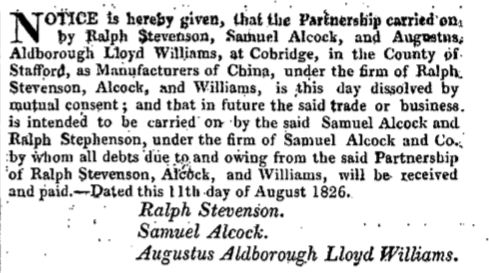
notice of the dissolution of
the partnership of Ralph Stevenson,
Samuel Alcock and Augustus Aldborough Lloyd Williams-
the business to continued by Samuel Alcock and
Ralph Stevenson and Samuel Alcock & Co
The London Gazette
16th August 1831
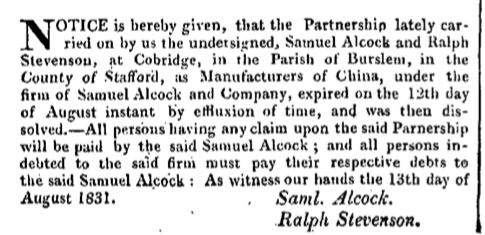
notice of the expiry of
the partnership between
Samuel Alcock and Ralph Stevenson
The London Gazette
14th October 1859
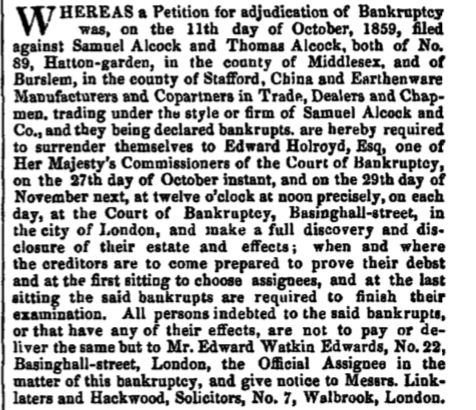
notice of declaration of
bankruptcy against Samuel Alcock (jnr)
and Thomas Alcock trading as Samuel Alcock & Co
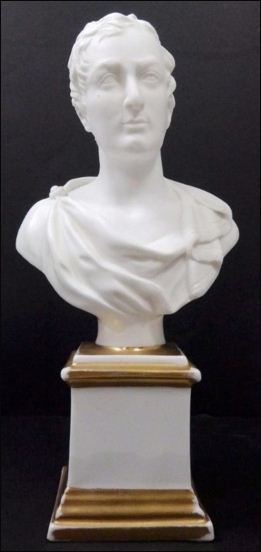 Parian Bust in the Roman style |
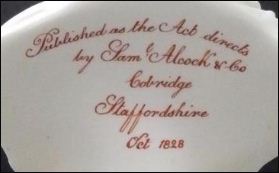 Published as the Act directs by Saml Alcock & Co Cobridge Staffordshire Oct 1828 |
registered by Samuel Alcock & Co at Cobridge, October 1828
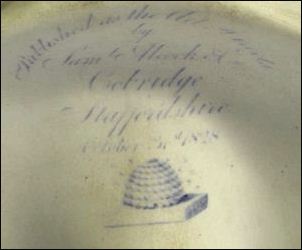
this mark with the date October 31st 1828, is found on a
bust of Lord Byron - the mark includes the bee-hive device
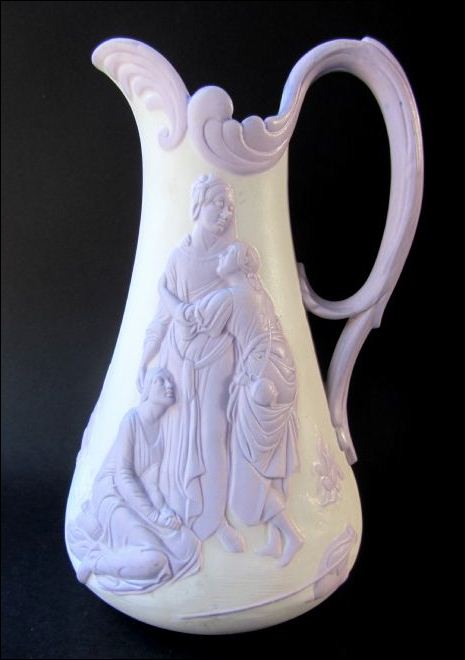 Naomi and her Daughters-in-Law Parian ware jug decorated in lilac relief |
'156' is a pattern number This version of the Royal Arms
was used by Alcock |
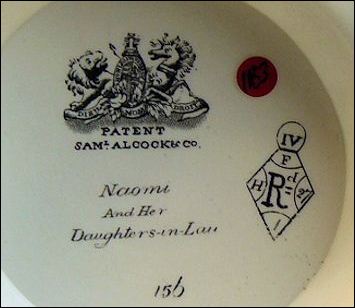
same mark as above with the
addition of the
name 'SAMl ALCOCK & Co'
Samuel Alcock & Co. majolica ware
moulded and decorated in bright colours with vines and flowering strawberry plantsthe back has impressed initials and beehive mark
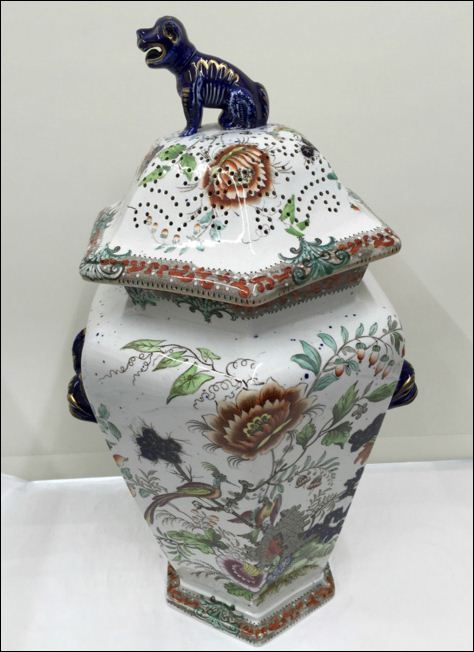
Alcock's Indian Ironstone vase with lid
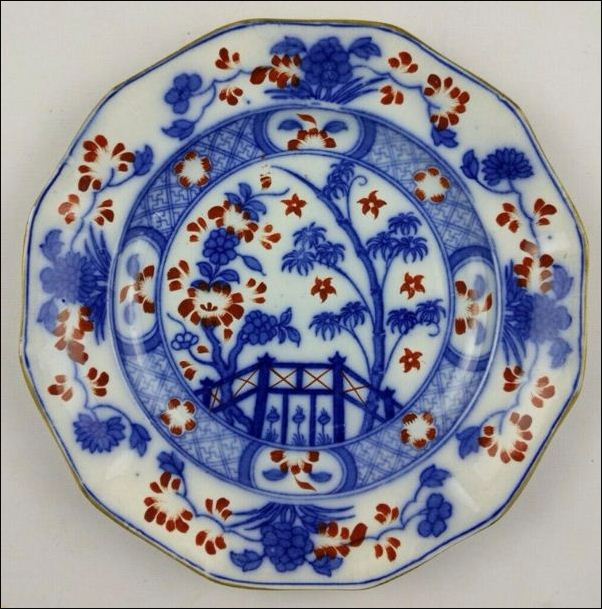 plate in the Indian Bridge pattern |
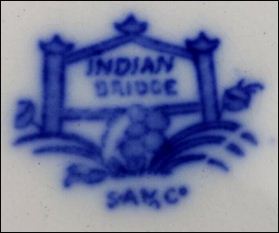 Indian Bridge S A & Co |
transferware printed plate in the Plume patternthe transfer used on this plate was actually designed for a slightly larger plate -
this can be seen by the fact that the edge of the border does not fit fully in all of the scallop
shapes of the plate and the border does not join up properly (bottom right) where it has been cut to fit the circumference of the smaller plate.
S. Alcock & Co
By Order of Stiffel Brothers Odessamark including the Royal Arms
S A & Co
mark includes a bee hive
Samuel Alcock produced this ware for the show rooms of the Stiffel Brothers
Francis Morley also produced ware for StiffelThe Stiffel brothers were importers who had a show room in Odessa, Russia from 1819 to 1858 it was a free port
photos courtesy: DeAnna Myers
hand coloured plate - after the willow pattern style
Indian Iron Stonethe arms are those of
the East India Company
plate in the Naples Shield printed pattern
Naples Shieldprinted pattern name with an impressed
ALCOCK and the bee hive mark
Initials & marks used on ware for identification:
|
The firm used printed, painted and impressed marks of many different styles. Most ware does not have a place name included. For those that do 'Cobridge' dates c.1826-53 and 'Burslem' dates 1828 to 1859. Many Samuel Alcock marks included a printed or impressed bee hive mark - the beehive was often used as a picture of industry and cooperation - the use of this mark on pottery appears to have first been used by Samuel Alcock. The Hill Works were subsequently used by many potters and some of them (e.g. Dunn Bennett and Burgess & Leigh) carried on the use of the beehive mark. When the company closed the models and moulds were sold to numerous buyers, and later ware from these moulds were often unmarked. |
S. A. & Co.
Saml Alcock & Co
S. Alcock & Co
these initials
and name appear as
printed or impressed marks
with and without the Royal Arms

Published as the Act
directs
by
Saml Alcock & Co
Cobridge
Staffordshire
Oct 1828
mark with the place name 'Cobridge'
|
Impressed mark on a raised pad '36' is the pattern number |
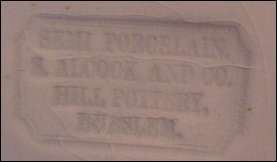 Semi Porcelain S Alcock and Co. Hill Pottery Burslem Impressed mark
|
examples of marks with the place name 'Burslem'
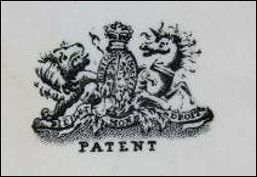
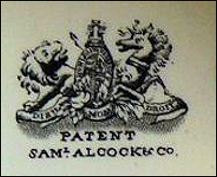
Marks incorporating the Royal Arms
were used by Alcock
- it appears with or without the initials S.A. & Co.
or the name below it -
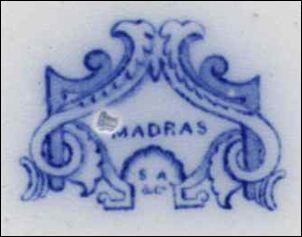
MADRAS
S A & Co
printed mark on
flow blue plate
'MADRAS' is the pattern name
The beehive mark:
 S. A. & Co |
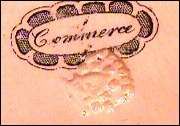 "Commerce" is the pattern name the mark is an impressed bee hive |
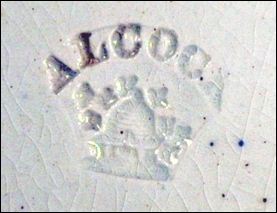 ALCOCK |
|
The beehive was often used as a picture of industry and cooperation - the use of this mark on pottery appears to have first been used by Samuel Alcock. The Hill Works were subsequently used by many potters and some of them (e.g. Dunn Bennett and Burgess & Leigh) carried on the use of the beehive mark. |
|
|
mark without the ALCOCK name |
Samuel Alcock & Co produced a series of patterns with the trade name 'Florentine China' the mark always includes the beehive symbol which was often used by Alcock, the name of the company does not always appear. |
|

Alcock's
Indian Ironstone
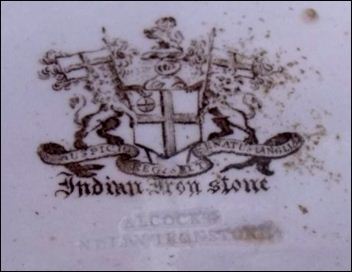
Indian Iron Stone
Alcock's
Indian Ironstone
| Alcock's Indian Ironstone
ware was no different than any other stone ware body that they produced
- the name was chosen for ware exported to the Indian
sub-continent. Sometimes the ware bears the arms of the East India Company - a notorious English trading company. Augustus Aldborough Lloyd Williams (a short term partner of Ralph Stevenson and Samuel Alcock) entered the navy in 1804. After discharge from the navy he went to India in the East India country-service. It was likely that he was able to aid sale of their ware to India through the company. |

- click for information on the Hill Pottery - In 1828 Samuel Alcock was also operating at the rented Hill Top pottery works in Burslem. In 1832, with his nephew Joseph, he brought the pottery works from the Robinson family and extensively rebuilt the works. The front was in a classical style - completed around 1839. The novelist Arnold Bennett called these works "Sytch Pottery" in his Clayhanger novels. |
Questions, comments, contributions? email: Steve Birks